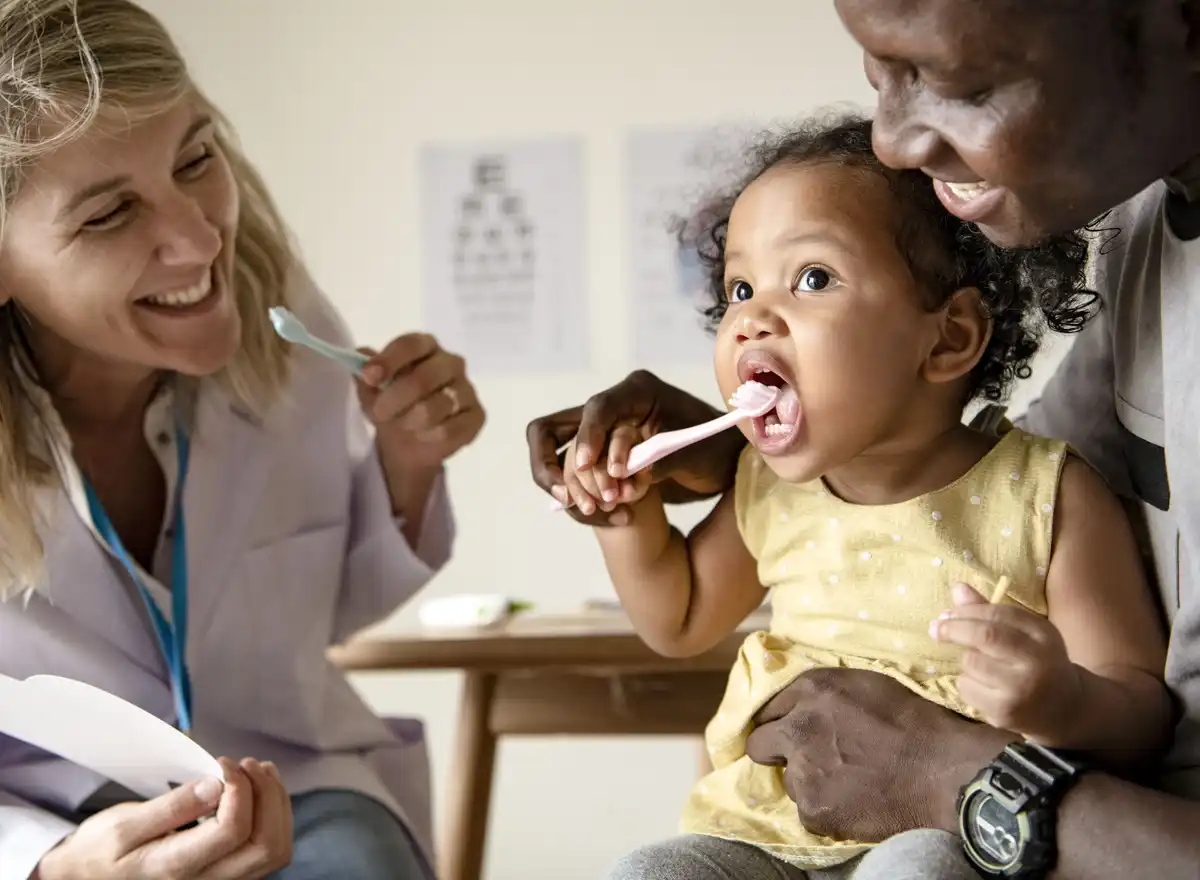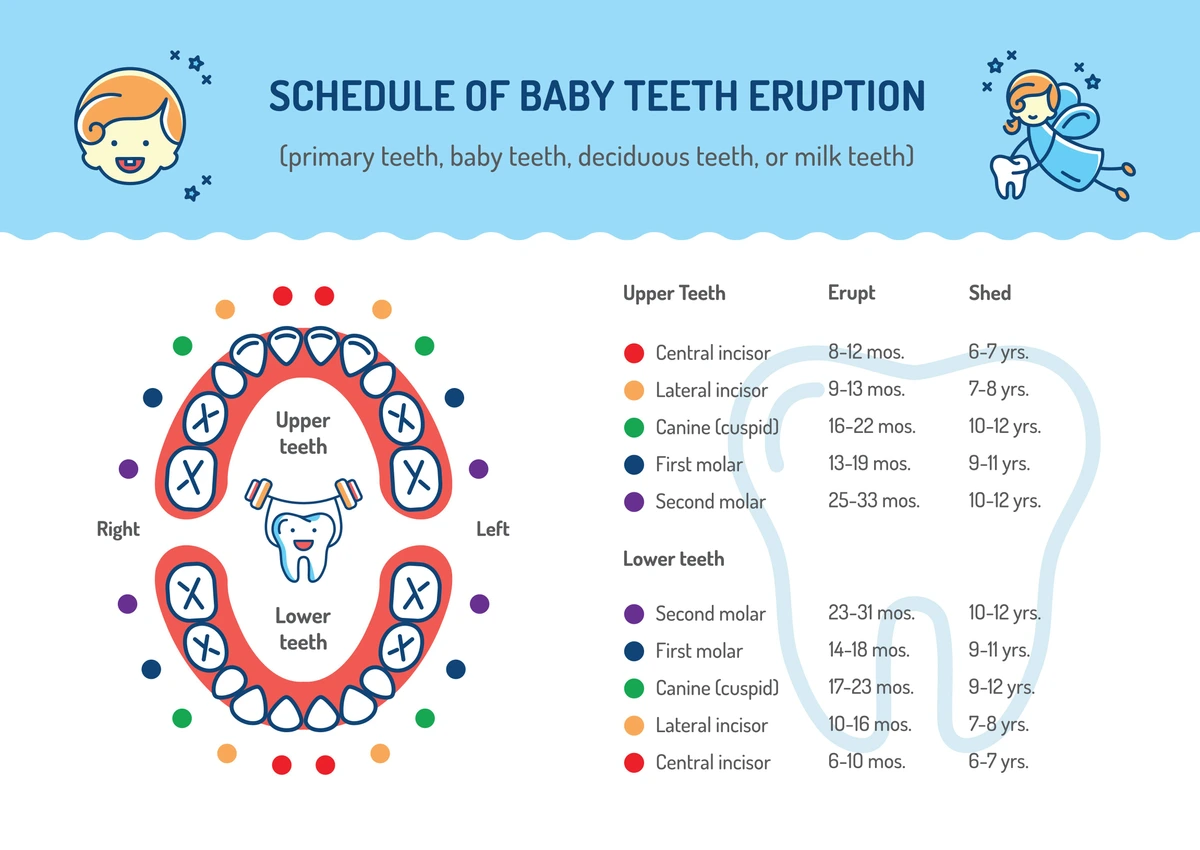Baby Teeth: When Does Teething Start & Eruption Chart


Your baby’s teeth or primary teeth are a preview of what’s to come when their adult permanent teeth erupt several years later.
How healthy they are, the positions they’re in, if they erupt properly, and when baby teeth fall out, it can affect everything from your child’s speech development to orthodontic complications when they’re a teenager.
Fortunately, watching your baby’s new teeth come in isn’t something that happens all at once. It’s a slow and steady process, giving you as a parent plenty of time to plan for their oral health.
Baby teeth typically start to appear between 6 and 10 months of age, with the lower central incisors (front teeth) usually being the first to emerge.

When Do Baby Teeth Come In?
Baby teeth come in at different times for different infants. As a general rule, a girl’s baby teeth will typically come in sooner than boys. What baby teeth come in first? It will almost always be the bottom two front teeth, followed by the teeth on either side of them.
You can typically expect to see about four primary teeth come in every six months. They erupt in pairs, with a partner on the right and left side of your child’s mouth. When do baby teeth come in?
Generally speaking, the order that baby teeth erupt is fairly consistent from one child to the next. If your child “skips” a particular tooth coming in and it still isn’t visible for several months, you should have their pediatric dentist check it out.
If you think about it, once your baby starts getting teeth they only have a few years with all 20 of them before they start falling out and being replaced with the adult version!
As your child’s baby teeth come in, don’t be alarmed if you notice big gaps between them. The extra space is a good thing! Since primary teeth (baby teeth) are way smaller than permanent, adult teeth, you want to have enough room between them so that their replacements don’t get all crowded and crooked when they try to fit their way in.
Once your child’s last set of molars come in around their 2nd birthday, you’ll be finished with the teething phase of infancy and toddlerhood. As you might expect, these last four teeth are frequently called the “2-year molars.” It will be about 3-4 more years before their adult teeth start to come in! You deserve a break, and here it is.
Baby Teeth Eruption Chart:

Why Are Baby Teeth Important & When Do They Fall Out?
Your child’s baby teeth are crucial to eating solid foods, learning how to talk and communicate, and saving space for their future adult teeth.
Some bad news about primary teeth or deciduous teeth is that they’re not as strong as adult teeth, because the enamel isn’t as dense. So, if your child gets a cavity, their baby tooth can erode far quicker than one of yours as an adult. You might say “Well that’s ok, their teeth were going to fall out anyway.”
Once it’s time for the teeth to start falling out, a natural process called “root resorption” takes place. This is the body’s way of eroding the root structure and reabsorbing the minerals back into the bone. Slowly but surely, the root starts to shrink, and the tooth gets loose. That’s why when baby teeth finally fall out, there’s usually little to no root surface left on them!
Most kids lose their first tooth around kindergarten, when they’re 5 or 6 years old. Again, girls tend to go ahead of boys. Baby teeth typically fall out in order of which they came in.
Teething Symptoms
You’ve probably heard people say just how “horrible” it is to have a teething infant. Baby teething symptoms can fluctuate from child to child, as can the severity of their symptoms.
Normally, infants between 4-7 months old will tend to exhibit the following if they’re teething:
- fussiness
- low-grade fever (Less than 101 F)
- lots of drooling
- swollen or tender gums
- problems taking naps or going to sleep
- seeming picky or fussy during meals
- chewing on things
Depending on who you ask, some people will say their baby exhibits viral symptoms such as a runny nose along with their low-grade fever (teething fever.) But if they have symptoms like diarrhea, vomiting, or a teething rash, that’s not a normal symptom of teething.
How To Soothe A Teething Baby
Teething babies tend to want to gnaw and chew on everything. Let them! Within reason, of course. This is usually a good stage to start introducing solid foods such as teething snacks, Cheerios, or saltine crackers.
Wash your hands and baby can chew on your fingers, too. As long as there aren’t many teeth in yet, it shouldn’t hurt.
Cool items can feel good on your baby’s gums. Refrigerate a pacifier, plastic feeding spoon, or baby teething ring and let them chew away. Don’t freeze them though, as it could do more harm than good. A clean, cool, damp washcloth is another great go-to.
Teething necklaces are extremely popular, but they can pose a serious choking hazard if the beads come off. There have even been some cases of them strangling babies. If you’re adamant about using one, never leave your baby alone with it or even turn your back for more than a few seconds. Simply having one on them in a car ride could be more time than needed for an emergency to take place. Instead, why not opt for a bracelet on their wrist instead of a necklace around their neck?
Medicine usually isn’t necessary for a teething baby’s gums. In fact, the FDA has come out and warned against pain-relieving topical gels like the ones that contain benzocaine. Consult your baby’s doctor for use of infant Motrin or Tylenol.
How To Soothe A Teething Baby
Teething babies tend to want to gnaw and chew on everything. Let them! Within reason, of course. This is usually a good stage to start introducing solid foods such as teething snacks, Cheerios, or saltine crackers.
Wash your hands and baby can chew on your fingers, too. As long as there aren’t many teeth in yet, it shouldn’t hurt.
Cool items can feel good on your baby’s gums. Refrigerate a pacifier, plastic feeding spoon, or baby teething ring and let them chew away. Don’t freeze them though, as it could do more harm than good. A clean, cool, damp washcloth is another great go-to.
Teething necklaces are extremely popular, but they can pose a serious choking hazard if the beads come off. There have even been some cases of them strangling babies. If you’re adamant about using one, never leave your baby alone with it or even turn your back for more than a few seconds. Simply having one on them in a car ride could be more time than needed for an emergency to take place. Instead, why not opt for a bracelet on their wrist instead of a necklace around their neck?
Medicine usually isn’t necessary for a teething baby’s gums. In fact, the FDA has come out and warned against pain-relieving topical gels like the ones that contain benzocaine. Consult your baby’s doctor for use of infant Motrin or Tylenol.
How To Care For Your Child's Teeth
You can start cleaning your child’s mouth well before their first tooth comes in. Use a clean, damp washcloth over your finger to rub their gums after every feeding.
Once the baby teeth start to rupture through the gums, the ADA (American Dental Association) recommends that parents use a rice-grain sized smear of fluoride toothpaste to brush their child’s teeth.
For the time being, stick to a small toddler toothbrush to make it easier to reach around all of the curves. Brush your child's teeth with small circular strokes on each tooth, cleaning the outside of all of the teeth, the inside, and all of the chewing surfaces.

As your baby turns into a toddler and then a preschooler, they’ll start to learn how to rinse and spit the toothpaste out for themselves. When they can, go ahead and progress to a pea-sized amount of fluoride toothpaste. Baby teeth may have plenty of room between them where they don’t touch. But if they do, it’s important to use floss to clean between them (since that’s a major place for cavities to start.)
For kids, it’s typically easiest to floss with a disposable flosser. You won’t really need to mess with the string floss until they’re a lot older.
TIP: If your baby tends to want to bite your fingers while you brush their teeth, buy an extra toothbrush with a larger handle, then let them bite the handle on one side of their mouth while you brush the other!
When To Start Brushing Baby Teeth
Start brushing your baby’s teeth as soon as they come through. In fact, cleaning their gums may actually offer some relief if they’re sore or swollen. You can give your older infant a baby toothbrush to play with or chew on throughout the day, but just make sure you’re still brushing for them in the meantime.
Make circular strokes on each tooth, one at a time. Pay careful attention to also brush the gums, which is where plaque tends to build up. Yes, kids can get gingivitis too!
Just like adult teeth, your baby’s smile needs to be brushed twice daily. You won’t have to brush for the full two minutes since they only have a few teeth, but the more frequently and longer you brush, the better it is for their teeth (and they’ll be more comfortable with having it done.)
If you’re able to, brush your baby’s teeth after every feeding. Since primary tooth enamel is weaker than permanent teeth, it can decay quicker. In fact, one of the most common childhood diseases is something called “baby bottle tooth decay” and it happens when babies go to sleep with a bottle or sippy cup with milk or juice in it.
Letting that liquid pool in their mouth over and over for hours at a time can lead to rapid tooth decay across their top front teeth. As your child gets older and can do things like tying their own shoes, it’s ok to start letting them brush their own teeth. But in the meantime, keep brushing their baby teeth for them.
Baby Teeth Takeaways
After your baby is born, you have anywhere from 4-12 months before their first tooth comes in. Being ready for teething will help everyone feel less stressed out.
Keep in mind that teeth erupt at various times from child to child. This is one of those developmental milestones that’s completely normal to start before or after other infants the same age.
Usually most babies will get their first tooth (one of the lower front ones) between 4-7 months of age. They’ll get 20 total, with their second or “two year” molars being the last four to erupt. It’s totally normal for babies to be fussy or even get a mild fever when they’re teething. Having clean, cool items on hand for them to chew on can relieve some of the soreness and discomfort that comes along with the process.
Taking care of your baby’s teeth will help prevent tooth decay, which can throw off their bite alignment and health of future adult teeth. Preserving natural spacing will also limit their risks of an orthodontic complication later on.
Brush your baby’s teeth twice per day and schedule their first checkup before they turn 1 year old (or soon after their first tooth comes in.)

Make your inbox smile!
Subscribe






